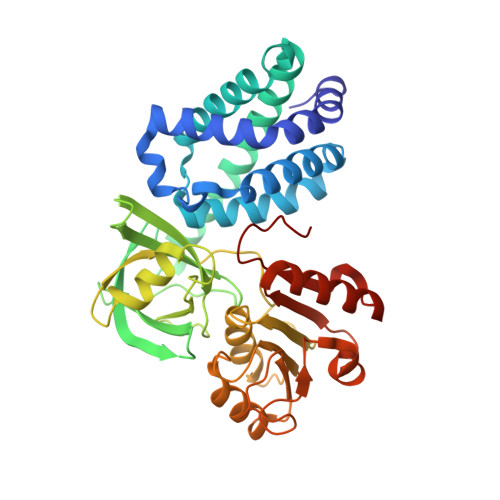Structure of Ralstonia eutropha Flavohemoglobin in Complex with Three Antibiotic Azole Compounds.
El Hammi, E., Warkentin, E., Demmer, U., Limam, F., Marzouki, N.M., Ermler, U., Baciou, L.(2011) Biochemistry 50: 1255-1264
- PubMed: 21210640
- DOI: https://doi.org/10.1021/bi101650q
- Primary Citation of Related Structures:
3OZU, 3OZV, 3OZW - PubMed Abstract:
Flavohemoglobins (flavoHbs) are enzymes that operate primarily as nitric oxide dioxygenases and shuttle thereby electrons among NAD(P)H, FAD, heme, and a ligated redox-active substrate such as O(2). They function in the bacterial defense against nitrosative stress and are therefore considered as targets for new antibiotic drugs. Recently, azole derivatives were proven to be attractive nitric oxide dioxygenase inhibitors, and to explore their binding characteristics, we determined the X-ray structure of the flavoHb from Ralstonia eutropha in a complex with miconazole (FHP(M)), econazole (FHP(E)), and ketoconazole (FHP(K)). In agreement with UV-vis spectroscopic data, one azole compound binds inside the distal heme pocket and ligates to the heme iron by its imidazole substituent. The two additional substituents, mostly chlorinated phenyl groups, form a series of van der Waals contacts with the protein matrix. Both interactions explain their high affinity for flavoHbs, the binding constants being 2.6, 1.2, and 11.6 μM for miconazole, econazole, and ketoconazole, respectively. The FHP(M) and FHP(Lip) (flavoHbs originally loaded with a phospholipid) structures share an "open" state and the FHP(E) and FHP(K) structures a "closed" state. Although the azole compounds were able to push the lipid out of its binding site, a fatty acid fragment is still bound inside the heme pocket of FHP(E) and FHP(K) and dictates the state of the protein. The ligand-induced open-to-closed transition involves a reorientation of the NADH domain accompanied by conformational changes in the C-terminal arm, helix E, and the CE loop resulting in an encapsulation of the heme-binding pocket. Implications of the observed open-to-closed process on the catalytic cycle are discussed.
Organizational Affiliation:
Laboratoire de Chimie Physique, CNRS-Université Paris-Sud 11, UMR8000, F-91405 Orsay, France.



















